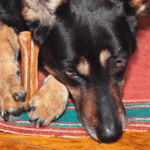Here are the symptoms of food allergies in dogs, plus an easy plan for diagnosis and treatment. My dog Georgie either has food allergies or intestinal bowel disease (IBD) – I don’t have an exact diagnosis because I’ve figured out how to keep her stomach calm.

Symptoms of Food Allergies in Dogs
Purina Pro Plan Dry Adult Dog Food for Sensitive Skin and Stomach is what I’ve been feeding Georgie, because real salmon is the number one ingredient. When you’re buying food for a dog you think might have allergies, make sure you look at the list of ingredients on the bag.
In What Causes Gurgling Stomach Noises in Dogs?, I describe how I diagnosed and treated my dog’s food allergies. Actually, since Georgie’s symptoms included blood in her poop and a gurgly tummy, I don’t think she is allergic to food. I believe she has intestinal bowel disease. The following symptoms of food allergies in dogs and a plan for diagnosis and treatment will help you figure out what to feed your dog.
Is Your Dog Allergic to His Kibble? Signs and Symptoms
Skin problems. The biggest symptom of a food allergy in dogs is a skin rash or sores near the face or ears. Itchy skin is a reaction to food, not necessarily a sign of fleas, hormones, or skin bacteria. I didn’t search online for other symptoms of food allergies in dogs, because my source says skin problems is the number one sign.
No or few gastrointestinal problems. In Dog, Bruce Fogel writes, “Surprisingly, food allergies in dogs may cause no gastrointestinal problems at all, but trigger an allergic response in the skin.” He adds that a true allergy to food in dogs does not occur until the dog is over a year in age. Puppies and adolescent dogs may not be able to tolerate some foods, and they’ll get diarrhea. This doesn’t mean the dog has a food allergy – diarrhea is not a symptom of food allergies in dogs. It’s just that the young dogs can’t handle some types of food.

“Symptoms of Food Allergies in Dogs” image by sipa via Pixabay, CC License
The cause of food allergies in dogs may be early gastrointestinal infections or early weaning. My neighbor’s dog Nico lost his mom when he was a few days old. He has always been a light, picky eater, and we think it may be because he wasn’t weaned properly. His mom was hit by a car shortly after he was born, and he’s just not into food.
Beef accounts for 60% of diagnosed cases of food allergies in dogs not because dogs are more likely to be allergic to beef, but because beef is the most common protein in dog food.
Food allergies in dogs are most likely to develop to proteins a dog has been previously eating. While some canine textbooks, veterinary websites, and dog blogs might say beef and dairy proteins are the most likely to cause food allergies in dogs, Bruce says allergies are more likely to occur to whatever type of protein the dog was eating. So, if my dog was eating fish or chicken protein, then she’s more likely to develop symptoms of a food allergy when she eats fish or chicken.
How to Diagnose Food Allergies in Dogs
Feed him fish or potato for at least six weeks. “Food allergy is diagnosed by feeding a novel and unique diet that the dog has not eaten before,” writes Bruce. “Because the dogs I see seldom eat either fish or potato, that’s the diet I usually recommend to see if anything in the former diet is provoking an allergic response.”
After six weeks, feed your dog his former food. If his skin or bowel problems return when you put your dog back on his regular diet, then you know he’s allergic to something in that food. Then, you might return him to his fish and potato diet so he’s able to enjoy his dog food without the symptoms of allergies!
The processing procedures of some commercial dog food may increase antigenicity (the capacity to react with an antibody and induce an immune response). So, processed dog food might trigger an allergic response, but fresh food with the exact same ingredients won’t cause symptoms.
Consider a mixture of homemade and store-bought dog food. I feed my dogs about half a cup of homemade chicken soup with a teaspoon of plain cooked rice, along with their fish and potato kibble. This has worked really well to calm Georgie’s intestinal bowel symptoms, and Tiffy just likes it.

Dog: The Definitive Guide
Here’s one more thought about dog food from veterinarian Bruce Fogle:
“Dog food comes in a great range of prices, and as with most things in life, the more you pay the better the quality of the product,” he writes in Dog: The Definitive Guide for Dog Owners.
“The cheapest dog foods are those with the cheapest ingredients and the smallest advertising budgets, and the most expensive dog foods are those with the highest quality ingredients and/or the largest advertising budgets.”
I welcome your thoughts below on the symptoms of food allergies in dogs. I’m especially interested in dogs who show other signs of food allergies, besides skin problems.


